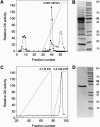D-GLYCERATE 3-KINASE, the last unknown enzyme in the photorespiratory cycle in Arabidopsis, belongs to a novel kinase family
- PMID: 15980259
- PMCID: PMC1182498
- DOI: 10.1105/tpc.105.033993
D-GLYCERATE 3-KINASE, the last unknown enzyme in the photorespiratory cycle in Arabidopsis, belongs to a novel kinase family
Abstract
D-GLYCERATE 3-KINASE (GLYK; EC 2.7.1.31) catalyzes the concluding reaction of the photorespiratory C2 cycle, an indispensable ancillary metabolic pathway to the photosynthetic C3 cycle that enables land plants to grow in an oxygen-containing atmosphere. Except for GLYK, all other enzymes that contribute to the C2 cycle are known by their primary structures, and the encoding genes have been identified. We have purified and partially sequenced this yet missing enzyme from Arabidopsis thaliana and identified it as a putative kinase-annotated single-copy gene At1g80380. The exclusive catalytic properties of the gene product were confirmed after heterologous expression in Escherichia coli. Arabidopsis T-DNA insertional knockout mutants show no GLYK activity and are not viable in normal air; however, they grow under elevated CO2, providing direct evidence of the obligatory nature of the ultimate step of the C2 cycle. The newly identified GLYK is both structurally and phylogenetically distinct from known glycerate kinases from bacteria and animals. Orthologous enzymes are present in other plants, fungi, and some cyanobacteria. The metabolic context of GLYK activity in fungi and cyanobacteria remains to be investigated.
Figures







Similar articles
-
An autoinhibitory domain confers redox regulation to maize glycerate kinase.Plant Physiol. 2010 Jun;153(2):832-40. doi: 10.1104/pp.110.157719. Epub 2010 Apr 22. Plant Physiol. 2010. PMID: 20413649 Free PMC article.
-
Measurement of Enzyme Activities.Methods Mol Biol. 2017;1653:31-50. doi: 10.1007/978-1-4939-7225-8_3. Methods Mol Biol. 2017. PMID: 28822124
-
Identification of the gene encoding homoserine kinase from Arabidopsis thaliana and characterization of the recombinant enzyme derived from the gene.Arch Biochem Biophys. 1999 Dec 1;372(1):135-42. doi: 10.1006/abbi.1999.1481. Arch Biochem Biophys. 1999. PMID: 10562426
-
Plant peroxisomes respire in the light: some gaps of the photorespiratory C2 cycle have become filled--others remain.Biochim Biophys Acta. 2006 Dec;1763(12):1496-510. doi: 10.1016/j.bbamcr.2006.09.008. Epub 2006 Sep 14. Biochim Biophys Acta. 2006. PMID: 17046077 Review.
-
The variety of photorespiratory phenotypes - employing the current status for future research directions on photorespiration.Plant Biol (Stuttg). 2013 Jul;15(4):737-47. doi: 10.1111/j.1438-8677.2012.00691.x. Epub 2012 Nov 21. Plant Biol (Stuttg). 2013. PMID: 23171236 Review.
Cited by
-
An in vivo metabolic approach for deciphering the product specificity of glycerate kinase proves that both E. coli's glycerate kinases generate 2-phosphoglycerate.PLoS One. 2015 Mar 30;10(3):e0122957. doi: 10.1371/journal.pone.0122957. eCollection 2015. PLoS One. 2015. PMID: 25823014 Free PMC article.
-
Increasing thermostability of the key photorespiratory enzyme glycerate 3-kinase by structure-based recombination.Plant Biotechnol J. 2025 Feb;23(2):454-466. doi: 10.1111/pbi.14508. Epub 2024 Nov 17. Plant Biotechnol J. 2025. PMID: 39550762 Free PMC article.
-
Comparative Proteome and Phosphoproteome Analyses Reveal Different Molecular Mechanism Between Stone Planting Under the Forest and Greenhouse Planting of Dendrobium huoshanense.Front Plant Sci. 2022 Jul 7;13:937392. doi: 10.3389/fpls.2022.937392. eCollection 2022. Front Plant Sci. 2022. PMID: 35873990 Free PMC article.
-
Rpivnt1 provides resistance through the mediation of a light responsive guardee in potato.aBIOTECH. 2021 May 11;2(4):415-418. doi: 10.1007/s42994-021-00045-2. eCollection 2021 Dec. aBIOTECH. 2021. PMID: 36311811 Free PMC article.
-
Proteome and Interactome Linked to Metabolism, Genetic Information Processing, and Abiotic Stress in Gametophytes of Two Woodferns.Int J Mol Sci. 2023 Aug 4;24(15):12429. doi: 10.3390/ijms241512429. Int J Mol Sci. 2023. PMID: 37569809 Free PMC article.
References
-
- Alonso, J.M., et al. (2003). Genome-wide insertional mutagenesis of Arabidopsis thaliana. Science 301 653–657. - PubMed
-
- Arabidopsis Genome Initiative (2000). Analysis of the genome sequence of the flowering plant Arabidopsis thaliana. Nature 408 796–815. - PubMed
-
- Black, S., and Wright, N.G. (1956). Enzymatic formation of glyceryl and phosphoglyceryl methylthiol esters. J. Biol. Chem. 221 171–180. - PubMed
-
- Blackwell, R.D., Murray, A.J.S., Lea, P.J., Kendall, A., Hall, N.P., Turner, J.C., and Wallsgrove, R.M. (1988). The value of mutants unable to carry out photorespiration. Photosynth. Res. 16 155–176. - PubMed
Publication types
MeSH terms
Substances
LinkOut - more resources
Full Text Sources
Other Literature Sources
Molecular Biology Databases
Miscellaneous

